Algarve-Tourist.com
The best independent guide to the Algarve
Algarve-Tourist.com
The best independent guide to the Algarve
Silves: Sights, attractions and historic monuments – for 2025
Beyond the sun-soaked beaches and tourist complexes of the Algarve lies Silves – a town where authentic Portuguese life thrives amid remarkable historical landmarks. As the former Moorish capital of the region, Silves combines centuries of fascinating history with the relaxed atmosphere of a traditional Portuguese town.
The distinctive red sandstone castle, ancient cathedral and winding streets offer visitors a genuine cultural experience that coastal resorts simply cannot match. Just a short train journey from the main Algarve beach destinations, Silves rewards day-trippers with unforgettable sights, excellent local cuisine and a true taste of Algarve heritage.
Overview of the major sights of SIlves
Here is a brief overview of all the major sights in Silves which you would want to see during your day trip. Detailed descriptions of all these sights are provided later in this guide.
Castelo de Silves - The imposing red sandstone fortress that dominates the Silves skyline dates back to the Moorish period. This well-preserved medieval castle offers spectacular views across the surrounding countryside and river from its massive walls and towers.
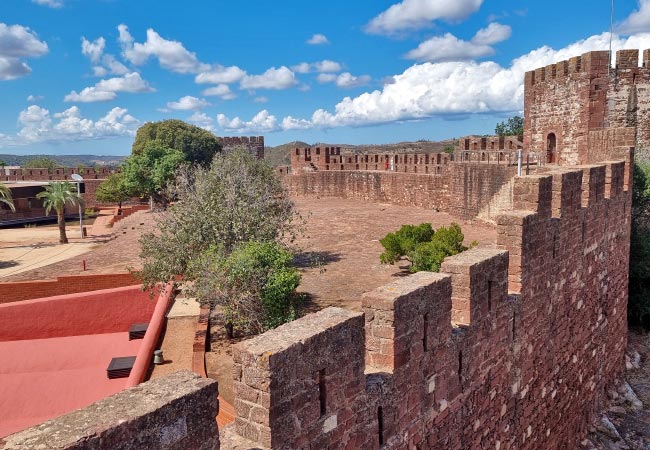
Sé de Silves - The ancient Silves Cathedral offers a striking architectural contrast between its white baroque façade and gothic red sandstone rear, with its impressive bell tower, ornate portal, and centuries of history.
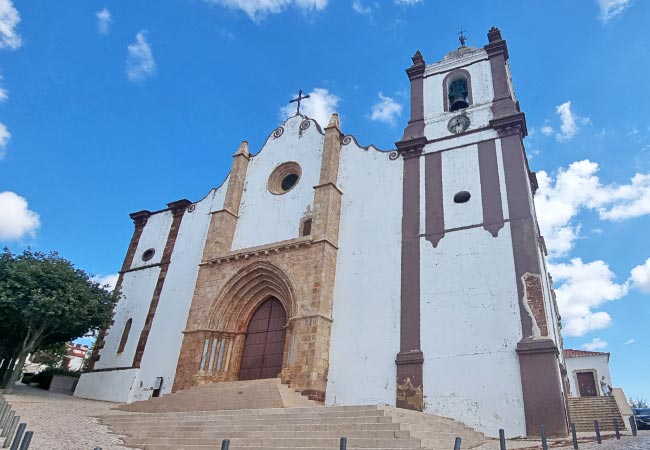
Portas da Cidade - The highly fortified Portas da Cidade stand as the last surviving medieval gateway into the ancient Moorish quart of the town.
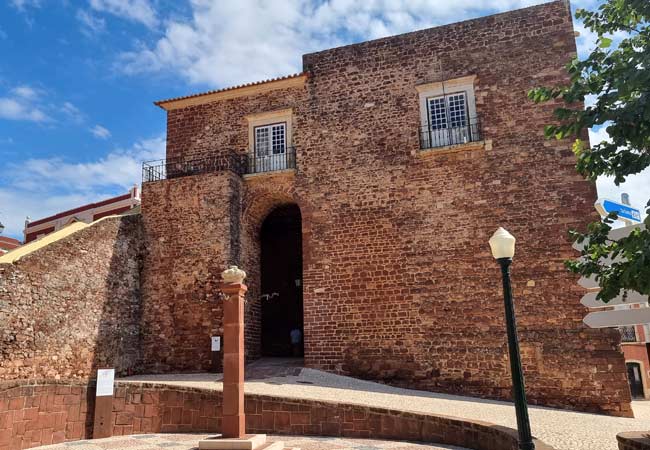
Archaeological Museum of Silves - Housed in a former water reservoir, this modern museum displays fascinating artefacts from the region's Roman, Visigothic and Islamic periods, providing context to the town's rich history.
Muralhas da Cidade - The remnants of Silves' ancient city walls, once fortified with 17 defensive towers, can still be glimpsed throughout the old town.
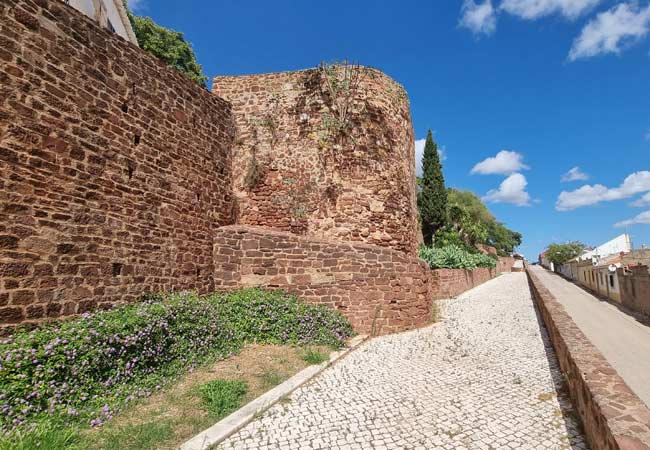
Ponte de Silves - The ancient bridge spanning the Arade River that served as the sole crossing point until the 19th century.
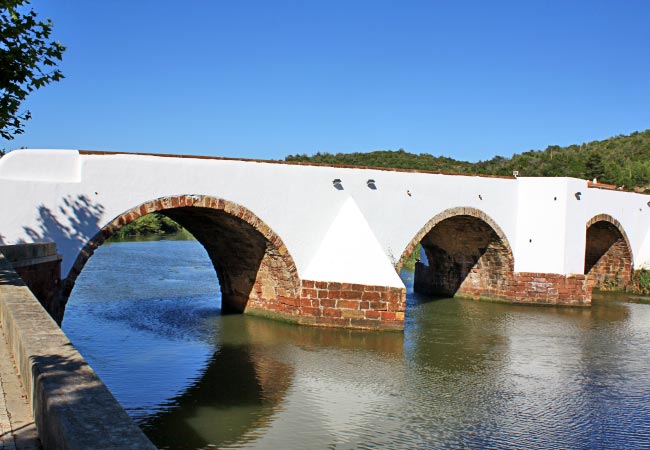
Municipal Market - The bustling local market offers an authentic glimpse into everyday Portuguese life, with stalls selling fresh regional produce, local handicrafts and traditional Algarvian goods.
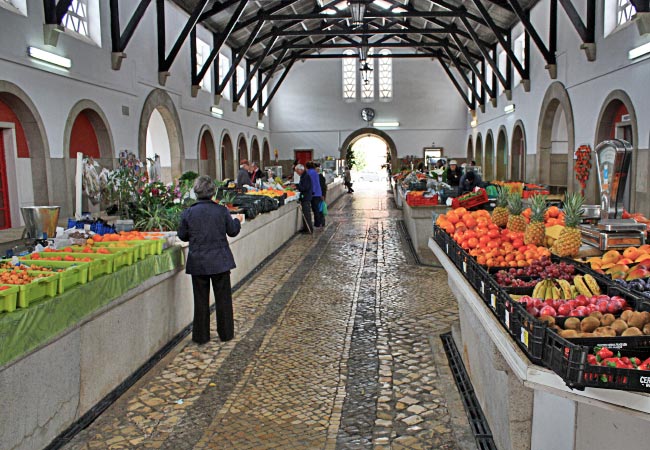
Cruz de Portugal - This ornate 15th-century limestone monument is one of Portugal's finest examples of Manueline stone carving, and the distinctive decorative style that emerged during Portugal's Age of Discovery.
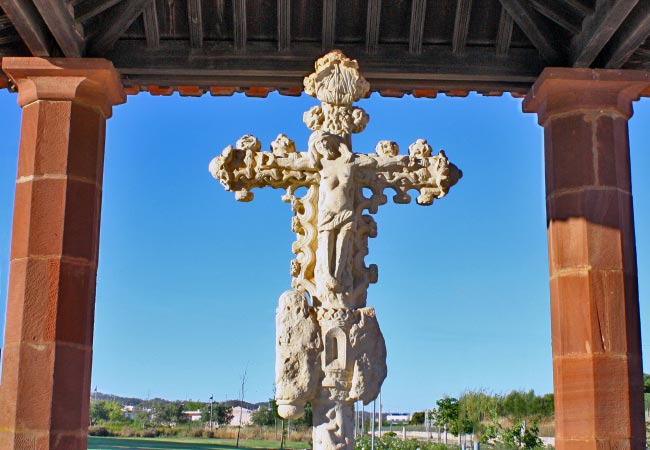
Map of the sights of Silves
The following map details the location of the sights of Silves detailed within this guide. Note: zoom in or out to see all of the points.
Legend: 1) Castelo de Silves (Castle) 2) Sé de Silves (Cathedral) 3) Archaeological Museum of Silves 4) Portas da Cidade (Gate) 5) Muralhas da Cidade (Walls) 6) Ponte de Silves (Bridge) 7) Municipal Market 8) Cruz de Portugal 9) Praça Al-Mutamid (Al-Mutamid Square) 10) Igreja de Nossa Senhora dos Mártires church 11) Pelourinho de Silves (Pillory) 12) Adega do Convento do Paraíso (Winery) 13) Quinta do Francês Winery 14) Barragem do Arade (Arade Dam and reservoir)
How about a tour of Silves?
An organised tour is a great way to visit Silves and to explore more of the surrounding region without the hassle of public transport. We have worked with GetYourGuide for the last seven years and some of their best tours which visit Silves include:
Detailed descriptions of the sights of Silves
Castelo de Silves
The magnificent red sandstone fortress that crowns Silves is one of the best-preserved Moorish castles in Portugal. Built between the 8th and 13th centuries, its distinctive reddish walls derive from the local red sandstone (grés de Silves) that gives the castle its unique character against the blue Algarve sky.
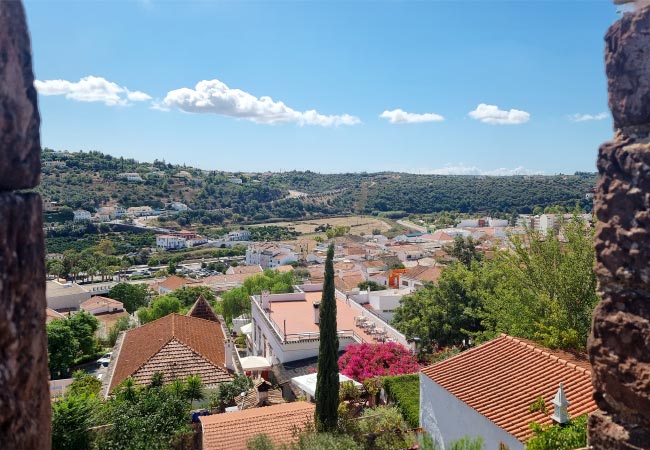
The view over Silves from the battlements
The castle served as the grand centrepiece of Al-Gharb (the Moorish name for the Algarve) when Silves functioned as the region's capital during Islamic rule. At its height, Silves was a sophisticated cultural centre renowned for poetry, learning and commerce.
In 1189, the castle fell to Crusader forces led by King Sancho I of Portugal with assistance from English, German and Flemish crusaders en route to the Holy Land. This victory was short-lived, as Moorish forces recaptured it just two years later. The castle finally came under permanent Portuguese control after the definitive Christian reconquest in 1249.
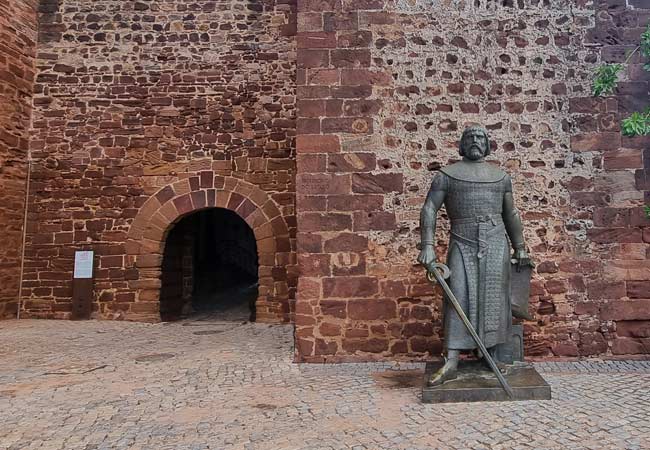
A statue of King Sancho I outside of the castle walls
Visitors enter through an impressive double-gated entrance system designed for maximum security. Inside, the castle reveals its architectural splendour with eleven massive towers that once protected the fortress, defensive walls reaching 10 metres in height and 2.8 metres in thickness, and medieval military features including arrow slits and battlements.
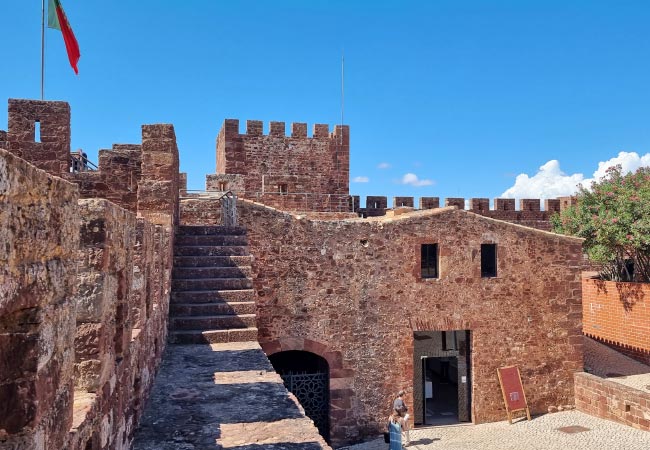
The entrance into the castle
The castle's ingenious water collection system demonstrates the advanced engineering skills of its Moorish builders. The main cistern (Cisterna da Moura) is an architectural marvel capable of storing 1.3 million litres of water—enough to sustain the castle during lengthy sieges.
This rectangular chamber measures 20m by 16m with a height of 7m, featuring a ceiling of four barrel vaults supported by twelve columns. Rainwater was cleverly channelled from the castle roof into this massive underground reservoir.
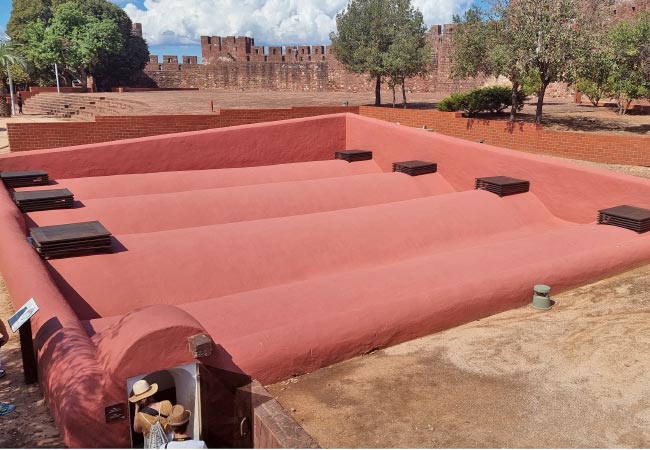
The roof of the reservoir
Within the castle walls stands another remarkable discovery—the remains of a rectangular two-storey palace-fortress covering 320 square metres. This structure, known as the Almohad Palace or Palace of Varandas (Balconies), is particularly significant as it's the only known Islamic palace in Portugal. The palace included living quarters, alcoves, courtyards, private bath areas in the Umayyad style, and several interior gardens—one with a portico and upper gallery.
The floors were once covered with marble and tiles, while the walls and arcades featured elaborate stucco detailing. The palace appears in poetry by Al-Mutamid, the poet-king who ruled Silves, who referred to it as "Xaradjibe." Historical accounts describe it as rivaling the palaces of Baghdad, surrounded by fragrant gardens and enjoying beautiful views across the landscape.
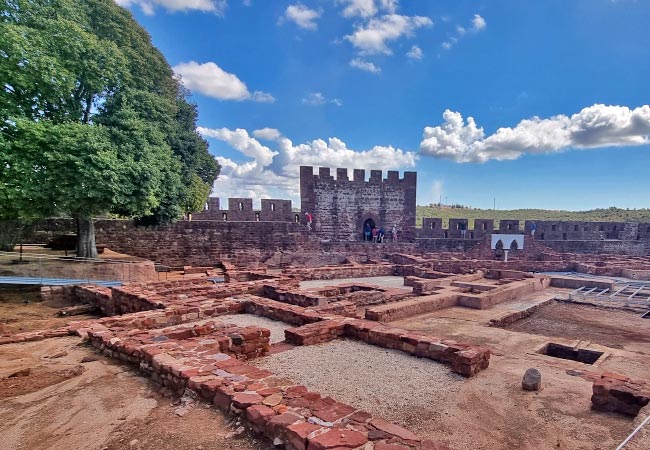
Another curious feature is the Cisterna dos Cães (Cistern of Dogs)—a deep well over 40 metres deep. The first 15 metres below the surface are rectangular in shape, becoming subcircular further down. According to local tradition, treasure hunters lowered dogs into it to search for Islamic treasures abandoned in the castle's underground areas, but the animals never returned, giving the cistern its intriguing name.
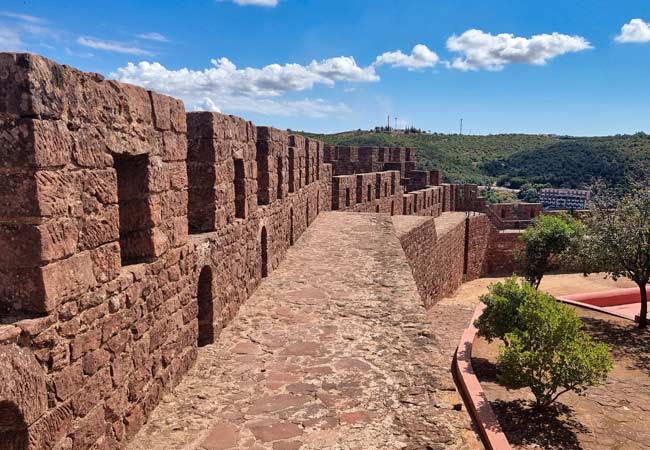
Silves castle is open every day from 9:00 AM to 8:00 PM during the summer season (March 25 to October 30) and 9:00 AM to 5:30 PM in the winter hours (October 31 to March 24). The Entrance fees is €2.80 for adults, with children under 14 entering free of charge.
Typical visits last around an hour to fully explore the castle, walking the battlements and descending into the historic Cistern
Within the castle is an excellent café, the Café Castelo de Silves (details and reviews - from google)
Silves Cathedral (Sé de Silves)
The imposing Silves Cathedral (Sé de Silves) stands as a remarkable testament to the city's rich religious heritage and historical significance. Located just a short walk from the castle in the heart of the old town, this Gothic cathedral was built on the site of a former mosque following the Christian reconquest of the Algarve.
Construction of the cathedral began in the late 13th century under the patronage of King Afonso III after Silves was definitively captured from Moorish control in 1249. However, much of the building was damaged during the devastating earthquake of 1755, which affected much of Portugal, leading to significant reconstruction work that has given the cathedral its current appearance.

The exterior of the cathedral features an austere façade dominated by a simple rose window and a striking Gothic portal. The building is constructed from the same distinctive red sandstone (grés de Silves) that characterizes the nearby castle, creating a visual harmony between the city's most important historical structures.
Stepping inside, visitors are greeted by a spacious interior with soaring columns supporting ribbed vaulting. The cathedral follows a traditional Latin cross plan with three naves. Despite its somewhat stark appearance compared to more ornate Portuguese churches, the cathedral possesses a dignified simplicity.
Among the most notable features inside are the tombs of crusader knights and bishops who played significant roles in the Christian reconquest and subsequent administration of the region. Of particular interest is the 14th-century tomb of João de Albuquerque, embellished with Gothic ornamentation. The cathedral also houses a beautiful baptismal font dating from the 16th century, carved from local stone.
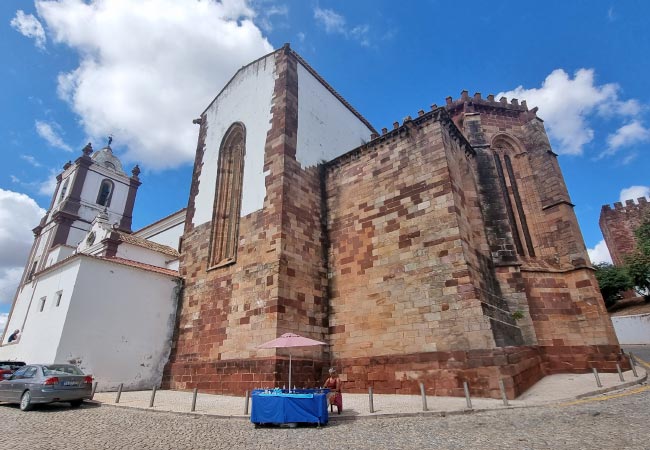
The main altar features a striking retable (altarpiece) in the Baroque style, which contrasts with the predominantly Gothic elements throughout the rest of the building. This artistic juxtaposition reflects the cathedral's long history and the various periods of renovation it has undergone.
The window designs incorporate geometric patterns that subtly reference the building's Islamic predecessor, creating a fascinating blend of cultural influences.
Portas da Cidade de Silves
The imposing City Gates represent the only surviving entrance to Silves' medieval walled town. Located near the Town Hall, this striking structure features a massive albarran tower built from the distinctive red sandstone that characterizes Silves' historical monuments.
Known locally as "Porta da Almedina" or "Torreão das Portas da Cidade," this gateway provided access to the main thoroughfare of the city -Rua da Sé - which during Islamic times connected to both the main mosque and the Alcáçova (citadel). The entrance is protected by a characteristic bend in its design, a deliberate defensive feature typical of Almohad military architecture intended to impede direct access to attackers.
This monument constitutes one of the two albarran towers of Silves' defensive walls—a special type of fortification tower that projected outward from the main wall and connected to it via a walkway, offering defenders strategic advantages. The tower above the gate contains two rooms and annexes, accessible via an exterior staircase (added later) and two original walkways.
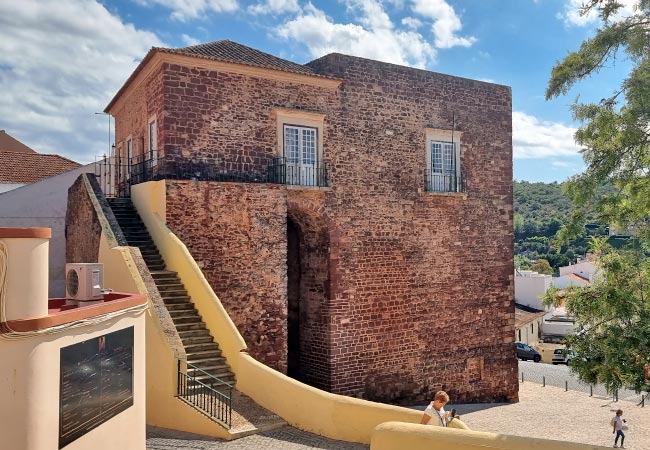
Archaeological Museum of Silves
Housed in a former water cistern dating to the Almohad period, the Archaeological Museum of Silves showcases the city's rich multicultural past through a fascinating collection of artifacts. The museum's modern, well-designed space incorporates the Islamic well-cistern as a dramatic central feature.
Exhibits span from prehistoric times through the Roman, Visigothic, Islamic and Portuguese periods, with particularly strong collections of Islamic pottery, architectural elements and everyday objects. Don't miss the rare 11th-century coin collection and the impressive well that reaches down to the water table, visible through a glass floor section.
Silves Cross (Cruz de Portugal)
Standing on the outskirts of town on the road to São Bartolomeu de Messines, the Silves Cross (Cruz de Portugal) is a remarkable example of Manueline stone craftsmanship. Created in the early 16th century, this limestone monument showcases the elaborate decorative style that emerged during Portugal's Age of Discovery.
The cross features intricate carvings including twisted ropes, botanical motifs, and religious symbols. Though weathered by time, the monument remains one of the finest examples of Manueline stonework in the Algarve and represents an important artistic treasure of the region.
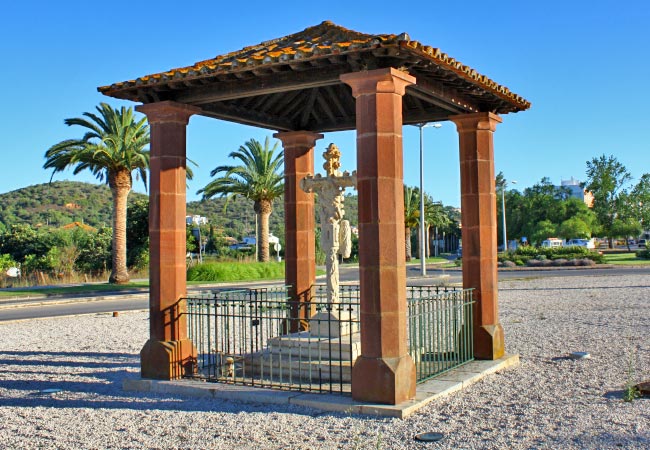
Ponte de Silves
The ancient bridge spanning the Arade River has been a vital crossing point for centuries. Often incorrectly called the "Roman Bridge," its true origins actually date back to the medieval period of the 14th-15th centuries. The structure's thin deck, smaller stone blocks bearing mason's marks, distinctive arch design, and wide spans all reveal its medieval craftsmanship rather than Roman construction techniques.
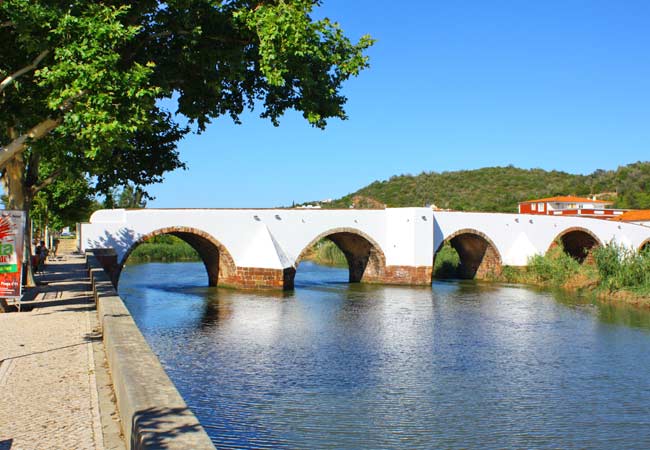
The Arade River that flows through Silves
Built from locally quarried Silves sandstone, this elegant structure stretches 76 meters in length and 5.5 meters in width. It features five graceful arches separated by three-sided pyramidal cutwaters that support a slightly raised deck. Until Portimão's bridge opened in 1876, all western Algarve land traffic passed through this crossing point at Silves, making it a crucial transportation link for the region.
The bridge is worth crossing for the wonderful viewpoint of the town on the opposite side of the valley.
Praça Al-Mutamid
This charming plaza pays tribute to Al-Mutamid Ibn Abbad, the celebrated 11th-century poet-king who ruled Seville and whose territory included Silves. Considered one of the greatest Andalusian poets, Al-Mutamid governed from 1069-1091 until being overthrown by the Almoravids and exiled to Morocco, where he died in 1095.
The square's centerpiece features a captivating sculptural ensemble of seven figures carved from local stone, depicting daily life in Islamic Silves. The carefully arranged groupings include three women standing together, two men carrying a traditional stretcher, and two seated figures—one believed to be Al-Mutamid himself—observing the others.
Four inscribed stones with Arabic text complement these sculptures, displaying excerpts from Al-Mutamid's renowned poetry and creating a thoughtful connection between the artistic and literary legacy of this influential ruler who shaped Silves' rich cultural heritage.
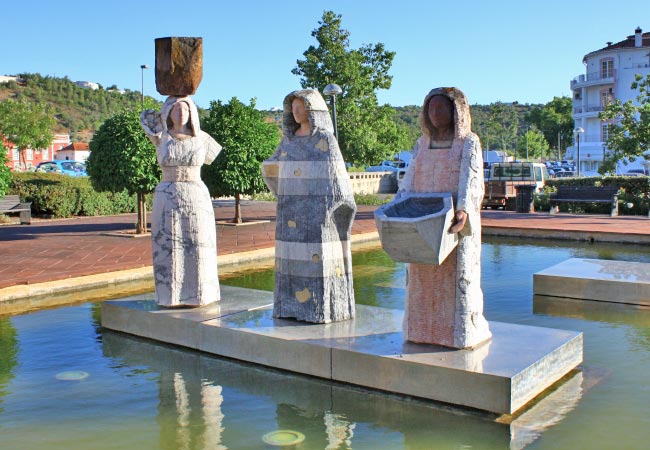
Igreja de Nossa Senhora dos Mártires
This fascinating late Gothic church has a rich history dating back to the 12th century. According to tradition, it was consecrated in 1189 by the bishops of Coimbra and Porto in the presence of King Sancho I to entomb Christians who died during the first conquest of Silves - hence the name "Martyrs." (Church of Our Lady of Martyrs).
The current structure mainly dates from the early 16th century, featuring a simple yet elegant geometric design with a single nave and a broken triumphal arch. Inside, you'll find a beautiful ribbed vault in the chapel shaped like a four-pointed star with five decorated keys displaying the Cross of Christ, sun and moon symbols, and the coat of arms of Queen Leonor.
Pelourinho de Silves (Silves Pillory)
This distinctive 16th-century pillory stands as a symbol of municipal autonomy and jurisdiction. The original pillory was dismantled during construction of a road, and was only reconstructed in 1989 near its original location.
It incorporates authentic elements from the original structure, including curved ironwork with serpent heads and rings typical of the Manueline style. Its most unique feature is the limestone royal crown added during Queen Maria I's reign in the 18th century, decorated with jewels and floral motifs converging at a cross.
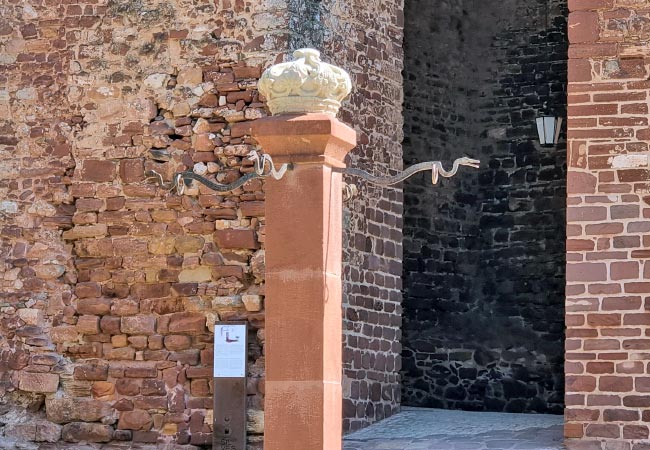
Mercado Municipal de Silves
The bustling Municipal Market offers a vibrant glimpse into authentic Algarvian life. Local farmers bring fresh seasonal produce daily, with stalls piled high with oranges, almonds, carob, figs and other regional specialties. The fish section features the morning's catch from nearby coastal towns, while other vendors sell local cheeses, honey, and traditional sweets. The market building itself, with its distinctive architecture, has been a gathering place for Silves residents for generations.

Muralhas da Cidade
Beyond the castle walls, fragments of Silves' extensive Moorish defensive system can still be seen throughout the town. The Islamic medina of Silves has been fortified since at least the 10th century, and featured an imposing defensive structure composed of wall sections and at least 17 towers.
These city walls once enclosed an area of approximately 9.75 hectares and were constructed using a distinctive military technique called "taipa militar." This strong mixture of clay, gravel, sand and lime was covered with the characteristic red sandstone blocks of the region, creating the impressive fortifications that partially survive today.

The inner city was accessible through several gates, including the Azóia Gate, the Sun Gate, and the Almedina Gate - the only one that survives today. The fortifications followed the natural contours of the land, with higher elevations to the east and north, while the southern and western sections developed midway up the slope.
The walls underwent major renovations between 1173 and 1189, with additional reinforcements continuing until the mid-13th century to strengthen them against Christian attacks. After the final Christian conquest, the defensive system remained important, with restoration work carried out during the reigns of several Portuguese monarchs including Ferdinand I, John I, Alfonso V, and Manuel I.
The earthquakes in 1722 and 1755 inflicted heavy damage to the walls. By the 19th century, the walls had lost their defensive function, and were used to supply stone for new buildings in the city.
Rio Arade
The Arade River has been the lifeblood of Silves, flowing from its source in the Serra do Caldeirão mountains through the historic city before emptying into the Atlantic Ocean at Portimão. During the Moorish period this waterway was navigable and transformed the inland settlement into a thriving port and commercial hub, enabling trade with North Africa and beyond.
The river provided not only economic prosperity through fishing, agriculture and commerce, but also natural protection against invaders. Although the gradual silting of the Arade over centuries diminished its navigability and contributed to Silves' eventual decline in regional importance.
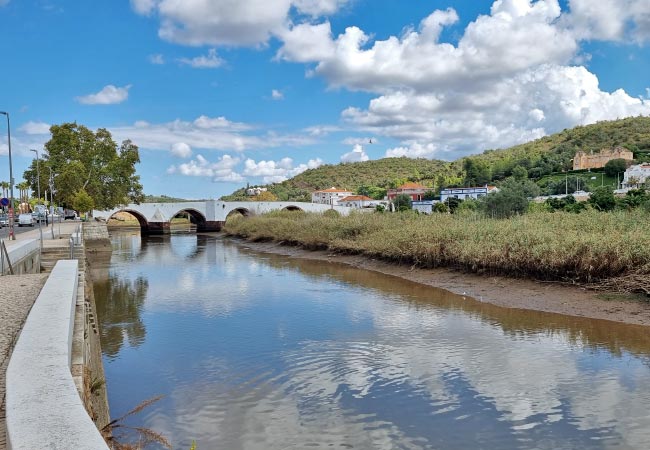
Wine tasting and vineyard tours of the Silves region
Adega do Convento do Paraíso
The Adega do Convento do Paraíso offers a compelling wine tasting experience just minutes from Silves. Set within the picturesque Quinta de Mata Mouros estate, this working winery blends traditional and modern techniques to create award-winning wines that showcase the region's unique terroir.
The estate's 12 hectares of vineyards, planted in 2000 on lime-clay soil that remained untouched for five centuries, produce distinctive varieties including Alicante Bouschet, Touriga Nacional, Alvarinho and Arinto. Visitors can tour the traditional winery with its blend of historic architecture and modern production methods, followed by tastings of their acclaimed wines including the prestigious Convento do Paraíso range, which recently earned a Great Gold Medal at the Algarve Wine Competition. Bookings must be arranged in advance through their website - www.conventodoparaiso.com/
Quinta do Francês Winery
The charming Quinta do Francês, often compared to a miniature Douro Valley, is located only 15 minutes by car from Silves
This boutique winery boasts 9 hectares of vineyards nestled in the hills overlooking the Odelouca River Valley, where vines flourish in the region's unique climate. Established in 2002, the vineyard grows primarily red varieties including Trincadeira, Aragonês, Touriga Nacional, Cabernet Sauvignon and Syrah on south-facing schist slopes, while their Cabernet Sauvignon and Sauvignon Blanc thrive in the alluvium soil near the river.
The modern winery, completed in 2008 in typical Algarvian architectural style, features state-of-the-art stainless steel tanks and French oak barrels. Visitors can enjoy guided tours with tastings of three wines for €15 per person. The welcoming showroom offers the opportunity to purchase their medal-winning wines and regional products while taking in spectacular views across the vineyard-covered hillsides.
www.quintadofrances.com
Barragem do Arade
To the north of Silves lies the tranquil Barragem do Arade (Arade Dam), one of the Algarve's most scenic inland water features. Completed in 1956, this reservoir was originally built to supply water for agriculture in the surrounding region, but today offers visitors a peaceful retreat from the coastal crowds.
The dam creates a stunning blue lake nestled among the gentle hills and valleys of the Algarve interior. Numerous bird species make their home here, including herons, egrets, and occasionally eagles soaring above.
Walking paths and unmarked trails wind around portions of the shoreline. One popular route follows the dam wall itself, providing spectacular panoramic views across the water to the hills beyond.
Our most popular guides to Silves and the Algarve
















